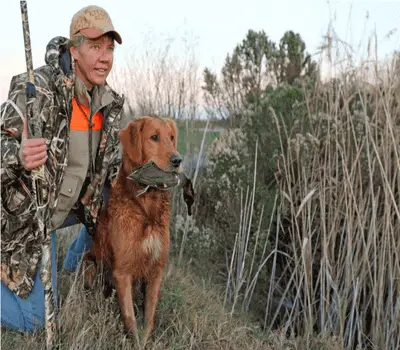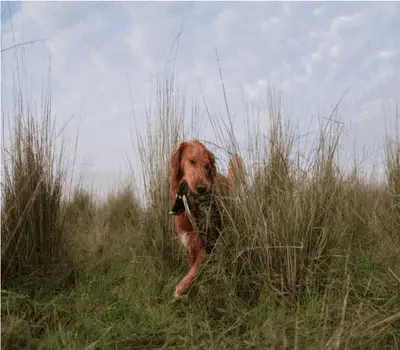Disclosure: We may earn commissions if you purchase products after clicking on a link from our site.
How to train your hunting dog is a major undertaking. It involves a well-thought plan, patience, and consistency. There will be bumps on the road, but if you are patient with your puppy, show love and understanding and stick to the training, it will pay off.
Dogs are man’s best friend and your dog will respond to the training based on how you bond with it and how you work with it in the training. Always remember that how well your puppy responds to the training is a reflection of the job you are doing to train it.

Table of Contents
How To Train Your Hunting Dog
- Have A Training Plan
Training your dog should be a fun and exciting thing for you and the dog. The most important thing is to have a plan for training. It doesn’t have to be long and complicated but should be a well-thought plan that you can slowly implement to get your dog ready to be part of your hunting team. Make notes of its successes and failures. The plan should also have ways to work on its failures to eventually get him trained.
2. Develop A Healthy Relationship With Your Dog
Develop a good relationship with your puppy. Dogs are affectionate and a good relationship with your hunting dog will only make it want to please you by doing what you want it to do. Spend time with it. Play with your dog and care for it. Building a relationship with your dog will also help it get along with other people like hunters, individuals, and other pets.
Many people have no issues with developing a good relationship with their dogs. At an early stage, start rewarding it for good deeds done. Get some toys for it to play with.
3. Carrying Crate
A carrying crate should be part of the training. It is always good to introduce your hunting dog to it early in its development and training. The carrying crate should not be used only for trips to the vet. That will have a negative impact on the dog. Take him to parks and other places using the crate.

4. Introduce Your Dog To The Outdoors
It is important that you introduce your dog to the outdoors and hunting grounds. Let it slowly get to know these areas, run and explore them. It will discover creeks, hills, meadowlarks, terrain features, birds, and many others as it becomes familiar with the countryside.
This will help it gain confidence in itself. It is important that your dog gets familiar with the sights, sounds, and scents of the terrain you will be hunting in.
5. Introduction To Water
If he isn’t comfortable with water yet, introduce him to it. Creeks, ponds, and other bodies of water will be part of the hunting terrain. Let it get familiar with water. This is also important if you hunt in a boat on the river. Introduce him to the boat and take rides in it.
6. Start With Basic Commands
Resist the urge to start your puppy with many commands. Start with just a few basic commands like “come”, “sit”, “heel”, “no”, etc. Too many commands, in the beginning, will only confuse your dog. As it learns a few commands, you can then introduce a few more. All of the training will be based on obedience. You want your dog to learn to be obedient to commands.

7. Introduction To Birds
As you progress with training your dog, you will want to introduce him to a bird. Use a decoy or dead bird. Let your dog hold the decoy or dead bird and get familiar with it. Don’t allow it to bite or shake it. Later on in the training, you want to introduce whistles, check cords, and other dog training supplies.
8. Let Your Dog Get Used To Gunshots
Don’t just assume that your dog will be ok with the sound of gunshots. You will have to slowly introduce it to that sound. If not trained to the sound of gunshots, it may become afraid and run scared of the sound when you hunt. Slowly introduce your dog to the sounds of gunshots.
It will be a work in progress for some time, but with a plan, your dog will eventually become accustomed to the sounds of gunshots and will hunt with you under the sounds of gunshots.
9. Locating & Retrieving Game
At some point in your training schedule, you will start training your dog in locating and retrieving game. Many hunters used quartering drills to train dogs on finding and flushing out games. Quartering drills train your dog to run back and forth in a zigzag pattern. This pattern helps them to locate game. Bumpers can be used to guide your dog when training it in the zigzag pattern. You can also use your arms to guide your dog in this training.
You can train your dog to retrieve game by using decoys. Do drills in which he goes out in the field, and locates and retrieves the decoys. You can throw the up in the sky and your hunting dog will learn to watch the skies for falling objects and retrieve them. Always reward the dog when it retrieves the decoy and brings it back to you. Training your dog to locate and retrieve game will not be quick and easy. You will have to do a good number of repetitions and be patient with your dog.

10. Training Supplies
You will need to get some training supplies as the training progresses. They will make the training more effective. You might want to get whistles, dummies, clickers, electric collars, etc.
Whistles help you control your dog as they easily get its attention and you can communicate with it using a whistle. It can also be used for tracking, herding, hunting, and searching. You can use different pitches to indicate commands to your dog. Repeating these often will help your dog connect the pitch to the command.
Dummies are ideal for training your dog, especially if you hunt ducks and geese. They can be used to train your dog on retrieving the game. Get the ones that are weighted like the actual duck it will retrieve. The best duck hunting tips are discussed in this article and you can read them through this link.
Clickers help you reinforce positive behaviors with your dog. They also help you communicate with your puppy without you barking out. Clickers give your dog a different signal than your voice and this helps to teach them positive behaviors. They are good when teaching your dog to sit and heel.
Dog Training Schedule
When the dog is 2 to 4 months old, you should start bonding with your dog and learning its personality. This is also the time to begin introducing it to the environment, other people like your family, neighbors, new places, sounds, noises, and things. Housebreaking and crate training is done during this age bracket.
The early months are also the time to train your puppy to a dog collar and leash. You want your puppy to get used to the collar and leash from an early age. You should also start training your puppy to retrieve items during this 2 to 4 months timeframe.
From 5 to 6 months, you should start training your hunting dog in basic commands like sit, heel, no, off, here, etc. Make these commands training short periods of training usually 5 to 15 minutes. You can also incorporate a little bit of this command training when you are spending some time with it besides training time.
This is also the time to slowly introduce your hunting dog to hunting situations and equipment. Hunting boats, hunting ground blinds, decoys, and live and dead birds are also introduced to your dog when it is 5 to 6 months old. You also want to introduce it to water and let it have fun in the water and start learning how to swim. Getting familiar with gunshots is very crucial to the development of your hunting dog. This is the time to introduce it to gunshots. We reviewed the best hunting ground blinds to help you find the right one if you are looking for a ground blind.
When your dog is 7 to 11 months old, it will have adult teeth. This is the ripe old age for real hunting training to begin. This is also the age range when you can get it professionally trained.
At this age, you also want to work on your hunting dog’s manners. This is when quartering drills reap the results. This is the time period when you want to train your dog to move close to you and not wander away when walking through a field.
You also want to train it to be quiet and not make noise or bark when you are hunting, especially in a hunting blind or for ducks, geese, and waterfowls. You also train your dog to learn to sit still for protracted periods of time in hunting blinds or boats while you hunt. You can learn how to deer hunt in ground blinds from this article.
When your hunting dog is 12 to 18 months old, it is ready to experience hunting! It must be stated that if your dog hasn’t been responding favorably to the training, then it just might not be ready for actual hunting even though it is 12 to 18 months old. If that is the case, you will want to go back and train your dog until it is carrying out the commands successfully.

How To Train Your Dog For Duck Hunting
Training your dog to hunt ducks follows closely with how you train your hunting dog for regular hunting. Building a good relationship with the dog is the foundation.
1. Work with your hunting dog to be obedient to your commands.
2. Train your hunting dog to be comfortable with decoys and not retrieve them, but rather the ducks.
3. If you will hunt from a boat, get your dog to be comfortable with water, riding in the boat, and exiting and entering it.
4. Train your dog to get familiar with the sounds of ducks. Use duck calls while you are training your hunting dog.
5. Training your dog to get accustomed to gunshots. You can follow a routine like blowing the duck call, shooting the gun, and throwing the dummy bird up in the air for the dog to retrieve it. This combination has a number of training points in it.
6. Remember that your dog may get excited at times during hunting and not follow the commands. This is normal. Don’t be too hard on it. Just work with it and get your dog back to obeying the hunting routine you have set out in the training.
7. You want to get your dog to learn the scent of ducks. Hence, you will want to use dummies that have the scent of ducks as well as the average weight of the ducks your hunting dog will be retrieving.
The Bottom Line
How to train your hunting dog is a major undertaking that could span a long period of time. However, it is worth it and you will increase your hunting team with another loyal and trained hunting partner. Training your dog to hunt, locate, flush out, and retrieve game requires a lot of patience, hard work, and consistency.
It is our hope that this article will help you with information on how to train your hunting dog. If you want dog training collars, then read this review of the best dog training collars.